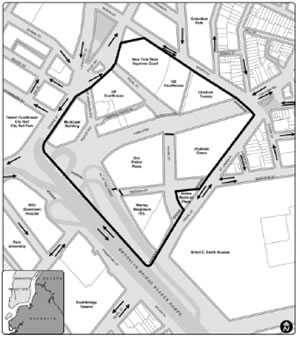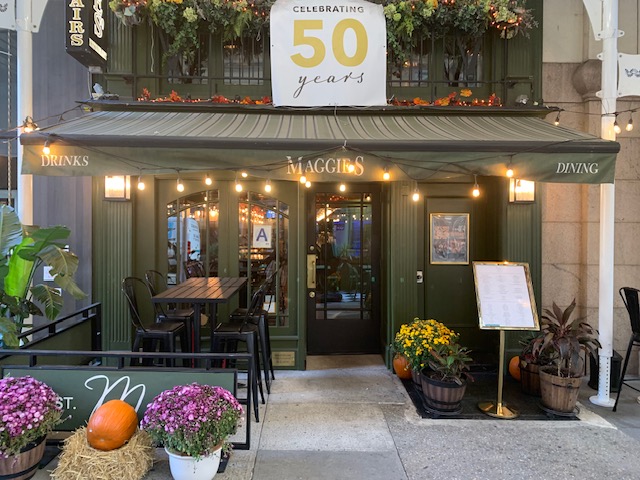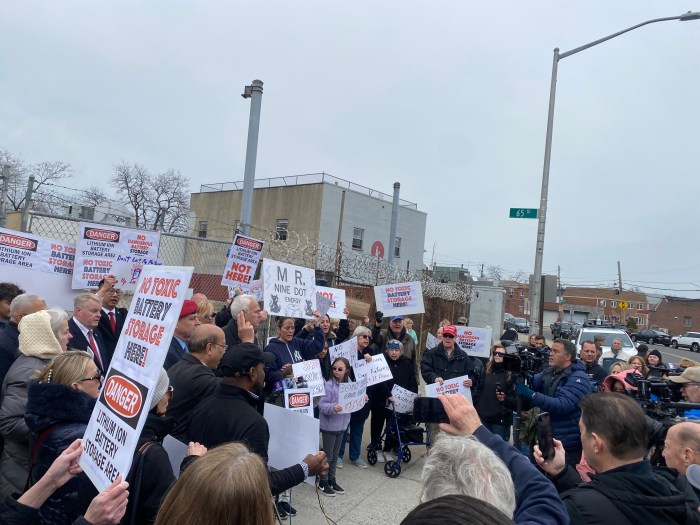By Julie Shapiro
After five years of arguments over the closure of Park Row, the city settled a lawsuit with Lower Manhattan residents.
The Civic Center Residents Coalition filed its first suit against the city in 2003, frustrated that the N.Y.P.D. refused to reopen Park Row or acknowledge the impact of the closure on the community. The N.Y.P.D. barricaded the street after 9/11 to keep police headquarters safe.
Under the settlement, the city will try to reduce the impact of the closure on pedestrians and ambulances traveling to Downtown Hospital. The city and N.Y.P.D. also agreed to meet with residents to discuss larger changes, such as shifting the barricades to open up more of the street.
“We were not asking for anything outlandish,” said Jeanie Chin, a Civic Center resident who spearheaded the effort to reopen Park Row. “It’s incredible we were forced to spend so much time and energy on this issue.”
When Park Row closed, traffic shifted onto surrounding streets, creating jams and a dangerous situation for pedestrians, Chin said. In the settlement, the city has promised to install a light and crosswalks on Worth St. at Baxter St. and on St. James Place at James St. The city will also consider installing a crosswalk on Worth St. at Mulberry St. The new crosswalks, Chin said, “are long overdue.”
The city installed the light at Worth and Baxter Sts. and the crosswalk at St. James Place and James St. before the settlement was finalized, as an act of good faith, a city official said.
“We’re trying to make a difficult situation better for the community,” said the official, who spoke on the condition of anonymity.
In addition, the city will place signs near the barricades that block off Park Row to tell ambulance drivers that they can use the street to get to Downtown Hospital. Park Row has long been open to ambulances, but drivers are not aware of that and take longer detours around, endangering patients, Chin said. The city will also place emergency defibrillators at the northern Park Row barricades. The defibrillators will arrive “in the very new future,” and the officers who staff the barricades will receive training in how to use them, the city official said.
Finally, the city and N.Y.P.D. agreed to meet with residents to discuss two unresolved issues. The first is the widespread placard-parking problem. Cars with N.Y.P.D. placards line the streets and sidewalks surrounding 1 Police Plaza, preventing shoppers from parking near stores and making it difficult for emergency vehicles to negotiate the narrowed streets. The N.Y.P.D. has reduced its placards in the past several months as part of a city initiative, but residents say that cars with police placards, both real and fake, continue to clog the streets.
The second topic of discussion will be the community’s request that the N.Y.P.D. move the northern barrier of Park Row 125 feet to the south. Moving the security barriers would allow cars to enter and exit the Chatham Green parking lot without having to pass through a checkpoint.
The N.Y.P.D. has repeatedly rejected this request, saying the move could put police headquarters at risk, but they will now reexamine it with the residents and outside security experts, under the terms of the settlement.
“We are pleased to have resolved [the lawsuit] amicably, and we look forward to moving ahead,” Chris Reo, a lawyer for the city, said in a statement to Downtown Express.
John Ost, a member of the Southbridge Towers board who joined Chin in filing the lawsuit, sees the settlement as a step in the right direction, but a small one. He is still concerned about the pervasive placard-parking problem, even given the promise of future discussions.
“This is best the police department can do?” Ost said. “Come on — we expect more from them.”
Ost wants to see Park Row reopened, but for now he and the other residents will focus on making sure the city follows the terms of the settlement.
The ultimate remedy for the residents will come from the political process, not the courts, said Roy Taub, an associate at Dewey & LeBoeuf, the firm that represented the residents.
“We are cautiously optimistic that the parties now see eye to eye,” Taub said. He does not envision future legal action regarding the impact of the Park Row closure as long as the City complies with the settlement agreement.
A group of attorneys at Dewey & LeBoeuf worked on the case pro-bono, but had they billed a client, they would have netted over $900,000 in the past four years, Taub said.
The Asian American Legal Defense and Education Fund also supported the residents in the suits.
The lawsuit just settled was filed last December, but it was part of a chain of legal actions that date back to 2003. Chin and other members of the Civic Center Residents Coalition were fed up with the city’s unilateral decision to close Park Row and felt the city left them no option but litigation.
The most recent lawsuit questioned the adequacy of the Environmental Impact Statement the city produced to describe the impact of the Park Row closure. The E.I.S. did not give enough consideration the impact of the closure on traffic, illegal placard parking, changes in community character, increased response times for emergency vehicles, weakened property values and alternatives proposed by the community, Taub said.
“The city’s consultant on the E.I.S. simply accepted the N.Y.P.D.’s conclusions, rejecting these community-proposed alternatives without any corroboration,” Taub said.
The city produced the E.I.S. after previous lawsuits filed by the residents. In the settlement, Taub and the other attorneys did not have to agree that the E.I.S. was adequate, and the residents still question its sufficiency. Usually, a developer will do an E.I.S. before a project is implemented, not afterwards, and the city will monitor the process. Here, the N.Y.P.D. was the one determining the impact of its own action. Also, the N.Y.P.D. did not analyze the impact of closing the street until it was already closed.
“They’re ignoring not only the future but the present,” Taub said. “The city is policing itself in this environmental review.”
The city employee, who did not give his name, defended the E.I.S.
“We stand behind it,” he said. “It’s a comprehensive and thorough review.”
Had Judge Walter Tolub ruled in favor of the residents in the most recent lawsuit, rather than approving the settlement, the city would likely have had to revise the E.I.S., a process that could have taken months or years. The settlement brought more immediate and more substantial results to the residents, Taub said.
The Park Row closure spurred the Civic Center Residents Coalition to advocate for the “Park Row bill,” which the City Council passed in 2005. The bill prevents the city from closing any streets in the future without due process. The bill did not apply to Park Row because several buses were restored, which means the street is not entirely closed, Chin said.
For Chin, the settlement’s success shows that residents need to stand up for themselves if they want anyone to listen.
“You can’t just steamroll over the community,” she said.
Julie@DowntownExpress.com
































